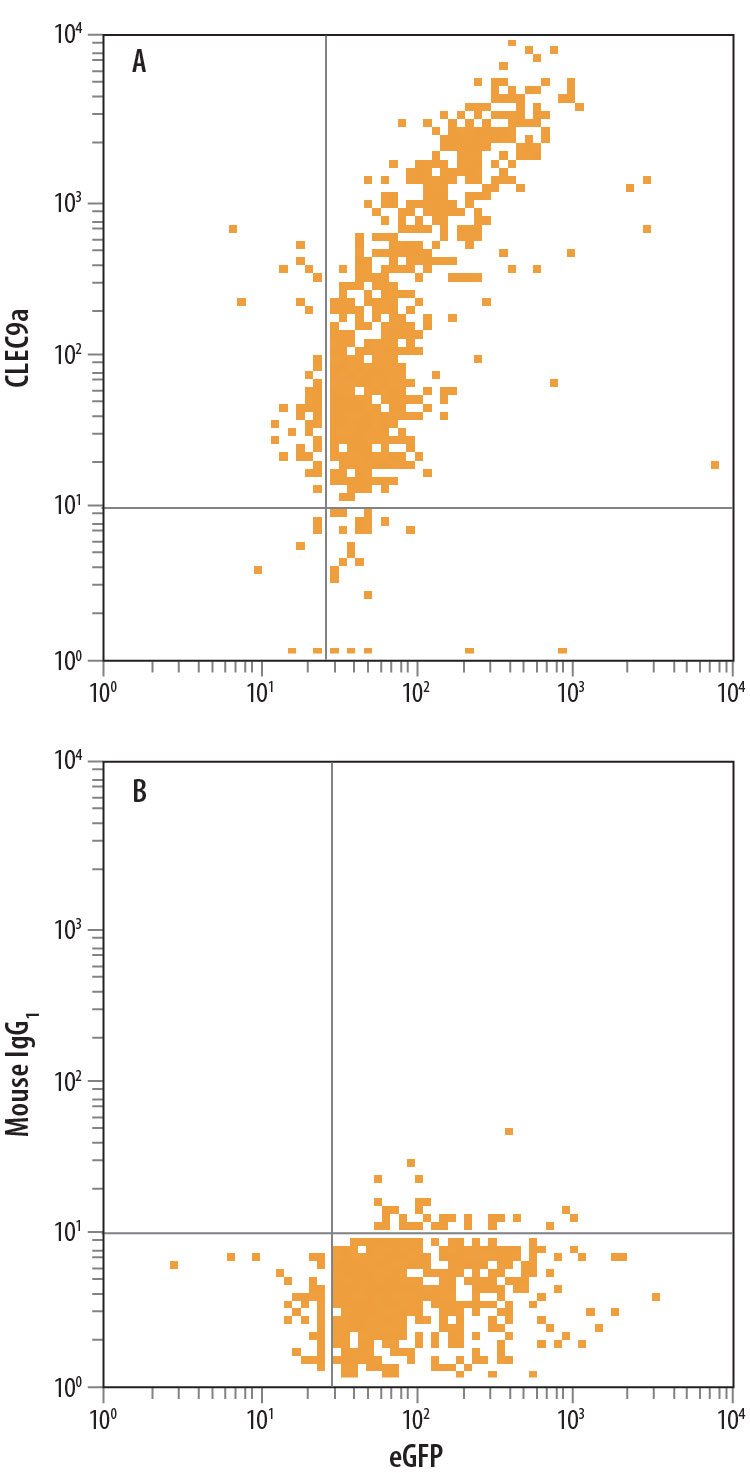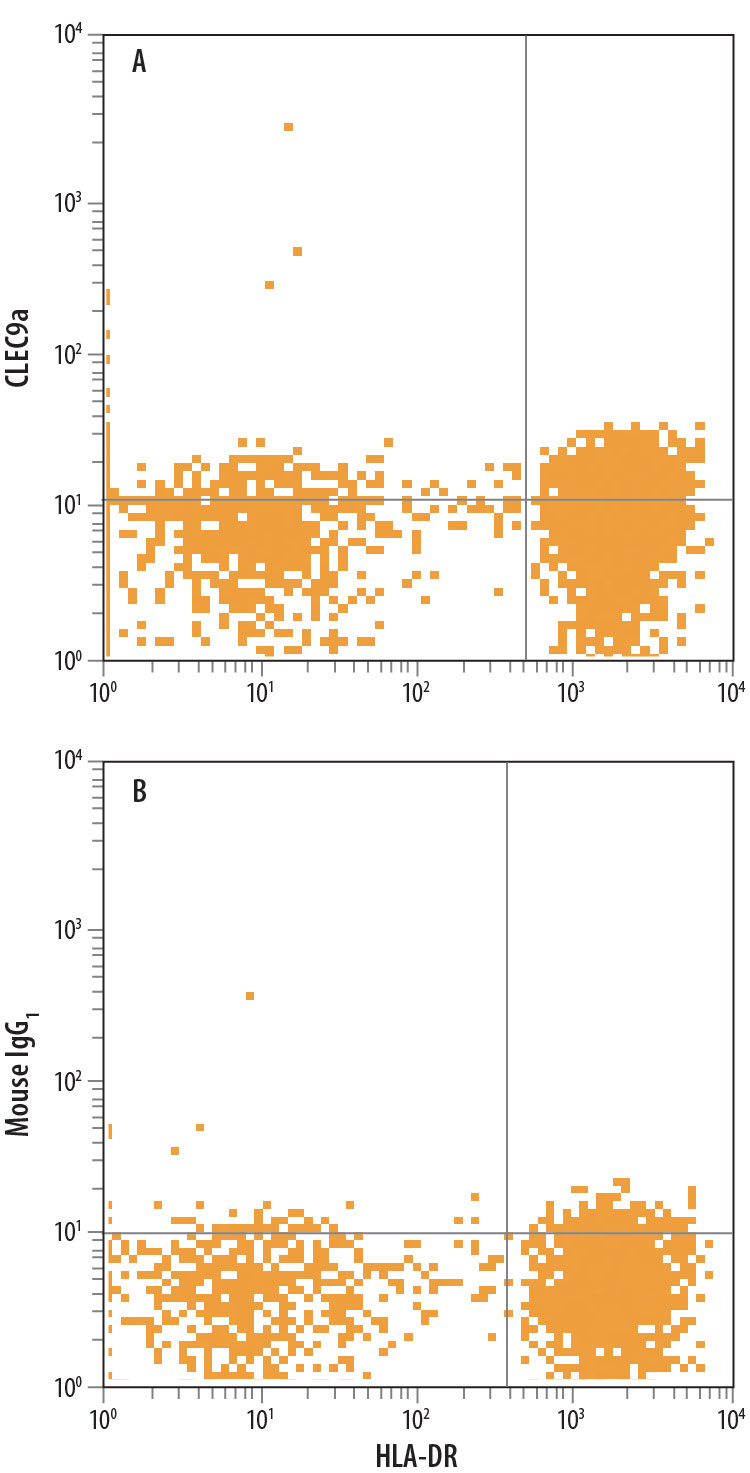Human CLEC9a APC-conjugated Antibody
Human CLEC9a APC-conjugated Antibody Summary
Lys57-Val241
Accession # Q6UXN8
Applications
Please Note: Optimal dilutions should be determined by each laboratory for each application. General Protocols are available in the Technical Information section on our website.
Scientific Data
 View Larger
View Larger
Detection of CLEC9a in HEK293 Human Cell Line Transfected with Human CLEC9a and eGFP by Flow Cytometry. HEK293 human embryonic kidney cell line transfected with human CLEC9a and eGFP was stained with either (A) Mouse Anti-Human CLEC9a APC-conjugated Monoclonal Antibody (Catalog # FAB6049A) or (B) Mouse IgG1Allophycocyanin Isotype Control (Catalog # IC002A). View our protocol for Staining Membrane-associated Proteins.
 View Larger
View Larger
Detection of CLEC9a in Human Peripheral Blood Cells by Flow Cytometry. Human peripheral blood cells gated on CD3-CD141+cells were stained with Mouse Anti-Human HLA-DR PE-conjugated Monoclonal Antibody (Catalog # FAB4869P) and either (A) Mouse Anti-Human CLEC9a APC-conjugated Monoclonal Antibody (Catalog # FAB6049A) or (B) Mouse IgG1Allophycocyanin Isotype Control (Catalog # IC002A). View our protocol for Staining Membrane-associated Proteins.
Reconstitution Calculator
Preparation and Storage
- 12 months from date of receipt, 2 to 8 °C as supplied.
Background: CLEC9a
CLEC9a (C-type lectin domain family 9 member A), also known as DNGR-1, is a type II transmembrane glycoprotein member of the C‑type lectin superfamily (1, 2). Mature human CLEC9a consists of a 35 amino acid (aa) cytoplasmic domain with an ITAM-like motif, a 21 aa transmembrane segment, and a 185 extracellular domain (ECD) that contains a stalk region and one C-type lectin domain (CTLD) (3‑5). Within the ECD, human CLEC9a shares 57% aa sequence identity with mouse and rat CLEC9a. Although the CTLD of CLEC9a structurally resembles that of other C-type lectins, it lacks the conserved residues that typically mediate calcium and carbohydrate binding. CLEC9a is expressed as a disulfide-linked homodimer of approximately 50 kDa N-glycosylated subunits (3, 5). Human CLEC9a expression is restricted to a subpopulation of BDCA-3+ conventional dendritic cells (cDC) and CD16- monocytes (3‑5). BDCA-3+ cDC are analagous to mouse CD8+ cDC which are specialized in antigenic cross-presentation in complex with MHC class I molecules (6). In mouse, CLEC9a is additionally expressed on plasmacytoid dendritic cells (4, 5). CLEC9a ligation enhances antigen uptake and processing, leading to presentation on MHC class I and cytotoxic T cell (CTL) priming (3‑5). In mouse, CLEC9a recognizes normally intracellular determinant(s) of necrotic cells and mediates their uptake by the dendritic cell (7). The subsequent antigenic cross-presentation to CTL is important for clearing necrotic cellular debris (7). CLEC9a signaling triggers activation of the tyrosine kinase Syk (3, 7).
- Huysamen, C. and G.D. Brown (2009) FEMS Microbiol. Lett. 290:121.
- Geijtenbeek, T.B.H. et al. (2004) Annu. Rev. Immunol. 22:33.
- Huysamen, C. et al. (2008) J. Biol. Chem. 283:16693.
- Caminschi, I. et al. (2008) Blood 112:3264.
- Sancho, D. et al. (2008) J. Clin. Invest. 118:2098.
- Dudziak, D. et al. (2007) Science 315:107.
- Sancho, D. et al. (2009) Nature 458:899.
Product Datasheets
Citations for Human CLEC9a APC-conjugated Antibody
R&D Systems personnel manually curate a database that contains references using R&D Systems products. The data collected includes not only links to publications in PubMed, but also provides information about sample types, species, and experimental conditions.
2
Citations: Showing 1 - 2
Filter your results:
Filter by:
-
Human XCR1+ dendritic cells derived in vitro from CD34+ progenitors closely resemble blood dendritic cells, including their adjuvant responsiveness, contrary to monocyte-derived dendritic cells.
Authors: Balan S, Ollion V, Colletti N, Chelbi R, Montanana-Sanchis F, Liu H, Vu Manh T, Sanchez C, Savoret J, Perrot I, Doffin A, Fossum E, Bechlian D, Chabannon C, Bogen B, Asselin-Paturel C, Shaw M, Soos T, Caux C, Valladeau-Guilemond J, Dalod M
J Immunol, 2014-07-09;193(4):1622-35.
Species: Human
Sample Types: Whole Cells
Applications: Flow Cytometry -
TLR3-responsive, XCR1+, CD141(BDCA-3)+/CD8alpha+-equivalent dendritic cells uncovered in healthy and simian immunodeficiency virus-infected rhesus macaques.
Authors: Dutertre C, Jourdain J, Rancez M, Amraoui S, Fossum E, Bogen B, Sanchez C, Couedel-Courteille A, Richard Y, Dalod M, Feuillet V, Cheynier R, Hosmalin A
J Immunol, 2014-04-16;192(10):4697-708.
Species: Primate - Macaca mulatta (Rhesus Macaque)
Sample Types: Whole Cells
Applications: Flow Cytometry
FAQs
No product specific FAQs exist for this product, however you may
View all Antibody FAQsReviews for Human CLEC9a APC-conjugated Antibody
There are currently no reviews for this product. Be the first to review Human CLEC9a APC-conjugated Antibody and earn rewards!
Have you used Human CLEC9a APC-conjugated Antibody?
Submit a review and receive an Amazon gift card.
$25/€18/£15/$25CAN/¥75 Yuan/¥2500 Yen for a review with an image
$10/€7/£6/$10 CAD/¥70 Yuan/¥1110 Yen for a review without an image


